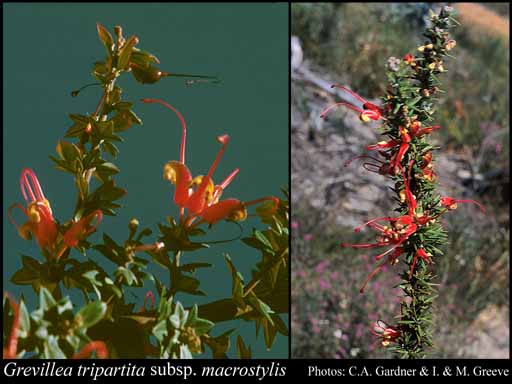- Reference
- Fl.Australia 17A:496 (2000)
- Conservation Code
- Not threatened
- Naturalised Status
- Native to Western Australia
- Name Status
- Current
Erect, spreading to compact shrub, (0.6-)1-3 m high, distinguished from Grevillea tripartita subsp. tripartita on limited foliar features. Fl. red-orange, Aug to Dec or Jan to Feb. Grey-white sand, orange gravelly clay, often over laterite. Slopes of shallow gullies, plains.

Scientific Description
Shrubs, 2-3 m high; branchlets hairy, not glaucous. Leaves alternate, 10-50 mm long, hairy, on the abaxial surface, the hairs straight; lamina flat, clearly widest below the middle, widest around the middle or clearly widest above the middle, once divided, tripartitely divided or divided only at the apex, entire or shallowly divided; lobes 5-20 mm long, 2-5 mm wide, the margins recurved. Inflorescences terminal, orange or red; pedicels (7-)8-10 mm long. Perianth 15-20 mm long; tepals all free after flower opens, hairy, glandular-hairy; ovary glabrous, stipitate, the stipe 1.5-3 mm long; pistil 40-45 mm long, orange or red, pollen presenter lateral, style glabrous. Follicles glabrous, not viscid, dehiscent, 12-18 mm long. Flowers in August, September, October, November or December. Occurs in the South-west (SW) Botanical Province(s), in the Esperance Plains (ESP) IBRA subregion(s).
Distribution
- IBRA Regions
- Esperance Plains.
- IBRA Subregions
- Fitzgerald, Recherche.
- Local Government Areas (LGAs)
- Dundas, Ravensthorpe.